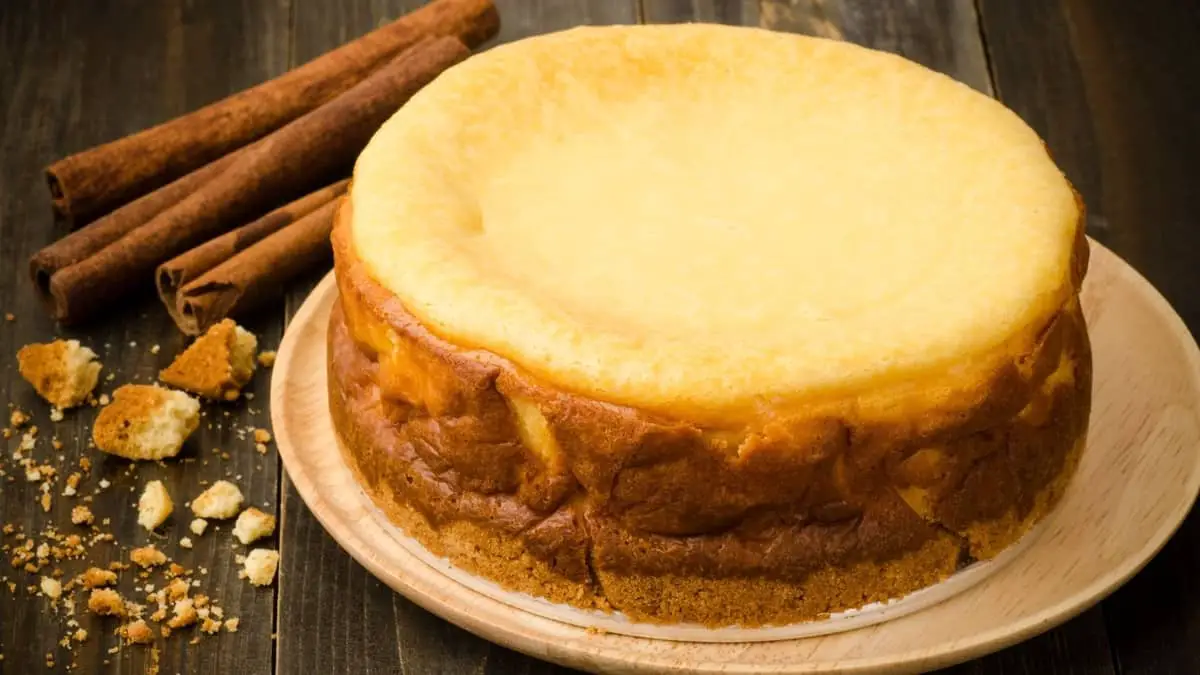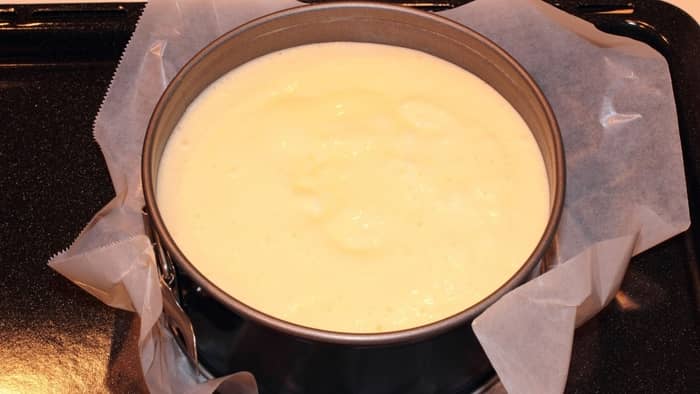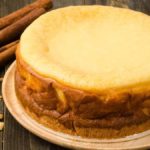Last Updated on February 8, 2023
Why did my cheesecake crack? Today, we will not only look at why but how to fix a cracked cheesecake.
There are tons of things that make a cheesecake crack! It is mainly due to the use of incorrect temperatures or drastic temperature changes. This includes using ingredients that aren’t at room temperature, using incorrect baking temperatures, and even cooling the cheesecake too quickly. We will be looking at exactly what makes a cheesecake crack and the many tips you can use to prevent it.
Why Did My Cheesecake Crack?
Cheesecake is an extremely delicious and often rich baked cake. It is made with some type of fresh soft cheese, eggs, and sweetener. The most common type of soft cheese that is used is cream cheese. However, today, it is becoming more popular to experiment with different types like ricotta, cottage cheese, goat’s cheese, or creme Fraiche.
You will also find that some people use semi-soft cheeses or matured soft cheeses like brie, Camembert, or Havarti. Using these requires a few extra steps, but creates an extremely interesting flavor.
Cheesecakes can be made with or without a crust and can be baked or unbaked (set in a fridge).
Baked cheesecakes are often the more difficult of the two. When making the baked one, the most common problem people run into is the cheesecake cracking.
Unfortunately, it doesn’t seem like anyone is explaining what makes a cheesecake crack or how to prevent the cheesecake from cracking – but we’re here to help.
What Makes a Cheesecake Crack?
When something cools down, naturally, the molecules contract. With cheesecake, the same thing happens. As it cools, the filling (or batter) contracts.
Unfortunately, cheesecake is prone to sticking to the sides of the pan. This is what creates the cracks – the sides sticking while the inside shrinks.
Now, while this explains how a cheesecake cracks, it doesn’t really explain why this sometimes happens and other times doesn’t.
Cheesecake cracks when it undergoes sudden and drastic changes in temperature. This makes the filling contract quicker than it can release from the sides.
Zulay Premium Springform Pan 9 Inch Nonstick – Cheesecake Pan With Removable Bottom
How to Prevent the Cheesecake From Cracking
Now, your cheesecake can crack for many reasons during virtually every step of the process. For example, when using cold or warm ingredients when preparing the batter. Or cooling the cheesecake too quickly after it has been baked.
It is extremely important to follow all of these tips below to ensure that you have flawless cheesecake every time! And, the steps are actually extremely easy.
Preparation Tips and Tricks
It is crucially important that your cheesecake batter is completely smooth and lump-free. This is not only because it will negatively affect the texture, but because lumps will cause the cheesecake to crack.
If your batter has different consistencies, it will contract and cool in different ways. This is what causes the cracks.
You also want to prevent making an airy (aerated) batter. Air pockets will expand when they are baked and cause the cheesecake to essentially rise and crack. While this is fine for normal cakes, it should be avoided at all costs with cheesecakes.
- Always use room-temperature ingredients. This includes cheese, eggs, and any liquids. This makes it easier to cream the ingredients together and create a smooth batter.
- Eggs can create aerated batters extremely easily. So, it is important to not over mix the batter. This will incorporate air and as we have mentioned before, will expand when baking and cause a crack.
- While you shouldn’t overmix the batter, you should still ensure you mix the ingredients until there aren’t any lumps. The easiest way to do this is to cream the soft cheese and sugar together before adding the eggs.
- Use a springform cake pan. They allow you to easily remove the cheesecake without creating a crack after it has been cooled.
Preventing Cheesecake From Cracking During Baking
Incorrect baking techniques can also cause the cheesecake to instantly crack. The key to baking a cheesecake is to supply the cake with a steady temperature and avoid drafts.
- Use a water bath to bake your cheesecake. Water baths provide a very uniform temperature and will bake your cheesecake slowly and evenly. It will also help prevent hot spots, which can cause cracks.
- Do not open the oven door until at least 80% of the baking time has passed. Opening the oven door will cause a drastic temperature change and will also create a draft inside of the oven.
- Do not overbake your cheesecake! This is the number one cause of cracked cheesecake during the baking phase. It causes the filling to contract too much while the sides are stuck to the pan.
- Your cheesecake is perfectly baked when about 2 inches of the center is slightly wobbly. Remember, the cheesecake will continue to “bake” while it is cooling.
How to Prevent Cracking Cheesecake During Cooling
After spending hours making and baking the cheesecake, it is such a shame that people rush the cooling part. This is arguably where most cheesecakes crack.
When cooling your baked cheesecake, you have to do it extremely slowly.
First, once the cheesecake has been fully baked (check the center) you can simply turn off the oven. Leave the door slightly open (you can also use a wooden spoon to keep it cracked open slightly). Allow the cheesecake to cool inside for about one hour.
Then, remove the cheesecake from the oven and allow it to cool at room temperature for another hour.
Once the cheesecake has cooled to room temperature, you can place it in the fridge and allow it to set for about 4 to 8 hours. Chilling the cheesecake overnight would be best.
While it is chilling in the fridge, tightly wrap the entire pan in plastic or saran wrap. This will help prevent it from drying out. Also, only remove the sides of the springform pan when you are ready to serve the cheesecake.
How to Fix a Cracked Cheesecake
Unfortunately, there are no ways to “fix” a crack in a cheesecake. However, there are ways you can hide it.
Method 1: Smooth Over the Cracks
Using a slightly heated knife or offset spatula, you can sweep over the top of the crack to smooth it over. Repeat this a few times until the crack is gone.
This only works for small cracks. It won’t take away the crack completely but will work when you have no other options.
Method 2: Pour Over a Glaze
This is possibly the best way to hide a crack, but only if you have the ingredients to make a glaze.
Adding a drizzle, glaze, frosting, or topping over the crack will hide it extremely well. And, it can also add some flavor. One of our favorite cheesecake drizzles is this Salted Caramel Chocolate Drizzle. It is a light glaze and you can easily determine how much to add.
For large cracks, however, you will need to add a thicker topping like our Pineapple Topping for cheesecake. It will cover the crack completely and add refreshing flavors.
Why Did My Cheesecake Crack?
As you’ve probably guessed by now, cheesecake cracks are extremely common. The three main ways to avoid cracks in your cheesecake are no overbaking, no sudden changes in temperature, and no drafts (such as from opening the oven during baking).
My Cheesecake Cracked While Cooling – Why?
If your cheesecake cracked while it was cooling down, it’s probably because it was overbaked. When a cheesecake is overbaked, it becomes dry and that’s when the cracks will start to show.
Is Overcooked Cheesecake Still Good?
As long as your cheesecake is not charred, it will undoubtedly still taste good. Besides an unappealing look and a dry texture; it should still taste just as delicious as you were expecting.
Crack-Free Cheesecake Recipe
If you’re looking for the perfect crack-free cheesecake recipe, that will yield ideal results every time, then look no further. For this recipe, you’ll need the following ingredients:
For the crust
- 2 cups of crushed graham crackers
- 1/2 teaspoon of cinnamon
- 1/2 cup of melted butter
For the filling
- 4 packets of softened cream cheese
- 1 cup of sugar
- 4 eggs
- 1 cup of sour cream
- 1 zest of a lemon
- 1 1/2 teaspoons of vanilla extract
For the topping
- 1 pint of raspberries
- 1 pint of strawberries
- 2 tablespoons of butter
- 3/4 cup of sugar
- 1 teaspoon of cornstarch
- 1 juiced lemon
Now all you need to do is:
- To make your crust, add the crushed graham crackers, cinnamon, and melted butter to a bowl and mix well.
- Lightly grease a 9-inch pan with cooking spray and add your bowl of crust to the bottom of your pan; pushing down firmly. Place in the fridge to chill.
- To make the filling, add the cream cheese to a bowl and beat for around a minute until smooth. Slowly pour in the sugar, mixing as you go. You should mix for around 2 minutes.
- After this point, individually add the eggs; ensuring the previous egg is combined before adding the next. Then add both the lemon zest and vanilla extract.
- Finally, add the sour cream and keep mixing until the filling is smooth. It’s important not to overmix at this point. Then add your filling on top of your crust, in your prepared pan. Smooth over.
- Add the cake pan into a water bath (such as a roasting pan), so it reaches around 1/2 way up the cake pan. Cover the sides of your cake pan in foil for the best results.
- Preheat your oven to 325F. Once preheated, add your water bath and cheesecake to the oven. Lower the temperature to 300 and bake for around 80 minutes. If your cheesecake is jiggling in the center – this is a good sign!
- Remove from the oven and loosen the edges with a knife so that it’s easier to remove from the pan when ready. Leave to cool for around 30 minutes at room temperature, and then at least a few hours in the fridge, for best results.
- To make the topping, add the berries, butter, lemon juice, sugar, and cornstarch to a pan and place over medium heat. Cook for a few minutes until the mixture begins to thicken. Once you have a chunky topping, remove it from heat and leave it to cool.
- Place on top of your chilled cheesecake. Slice, serve, and enjoy!
Final Thoughts – How to Fix a Cracked Cheesecake
By simply following our tips when making, baking, and cooling cheesecake, you can have a flawless product every time! Let us know what you think in the comments below and share it with your fellow cheesecake lovers.
Read more about Why Does Pumpkin Pie Crack
Crack-Free Cheesecake Recipe
Ingredients
for the crust
- 2 cups crushed graham crackers
- 1/2 tsp cinnamon
- 1/2 cup melted butter
for the filling
- 4 packets softened cream cheese
- 1 cup sugar
- 4 eggs
- 1 cup sour cream
- 1 zest of lemon
- 1 1/2 tsp vanilla extract
for the topping
- 1 pint raspberries
- 1 pint strawberries
- 2 tbsp butter
- 3/4 cup sugar
- 1 tsp cornstarch
- 1 juiced lemon
Instructions
- To make your crust, add the crushed graham crackers, cinnamon and melted butter to a bowl and mix well.
- Lightly grease a 9 inch pan with cooking spray and add your bowl of crust to the bottom of your pan; pushing down firmly. Place in the fridge to chill.
- To make the filling, add the cream cheese to a bowl and beat for around a minute until smooth. Slowly pour in the sugar, mixing as you go. You should mix for around 2 minutes.
- After this point, individually add the eggs; ensuring the previous egg is combined before adding the next. Then add both the lemon zest and vanilla extract.
- Finally, add the sour cream and keep mixing until the filling is smooth. It's important not to overmix at this point. Then add your filling on top of your crust, in your prepared pan. Smooth over.
- Add the cake pan into a water bath (such as a roasting pan), so it reaches around 1/2 way up the cake pan. Cover the sides of your cake pan in foil for best results.
- Preheat your oven to 325F. Once preheated, add your water bath and cheesecake into the oven. Lower the temperature to 300 and bake for around 80 minutes. If your cheesecake is jiggling in the center - this is a good sign!
- Remove from oven and loosen the edges with a knife so that it's easier to remove from the pan when ready. Leave to cool for around 30 minutes at room temperature, and then at least a few hours in the fridge, for best results.
- To make the topping, add the berries, butter, lemon juice, sugar and cornstarch to a pan and place over a medium heat. Cook for a few minutes until the mixture begins to thicken. Once you have a chunky topping, remove from heat and leave to cool.
- Place on top of your chilled cheesecake. Slice, serve and enjoy!

Lindy Van Schalkwyk is a culinary specialist with a background in Advanced Cooking, Advanced Pâtisserie, Media Communications and Nutrition. She has gained invaluable experience in the culinary industry having worked in some of the top restaurants in Africa in 2016 and 2017. Her expertise in nutrition has enabled her to develop recipes for special dietary needs. In 2018, Lindy began working in the Food Media industry, focusing on recipe development, recipe writing, food writing and food styling.




